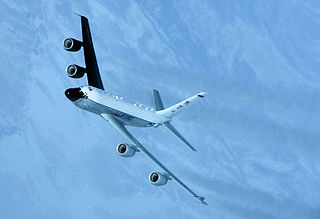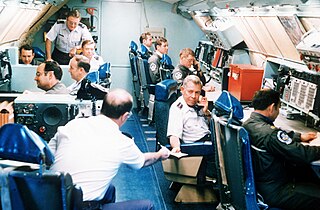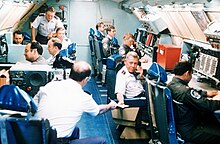
Strategic Air Command (SAC) was a United States Department of Defense Specified Command and a United States Air Force (USAF) Major Command responsible for command and control of the strategic bomber and intercontinental ballistic missile components of the United States military's strategic nuclear forces from 1946 to 1992. SAC was also responsible for strategic reconnaissance aircraft; airborne command posts; and most of the USAF's aerial refueling aircraft.

Offutt Air Force Base is a U.S. Air Force base south of Omaha, adjacent to Bellevue in Sarpy County, Nebraska. It is the headquarters of the U.S. Strategic Command (USSTRATCOM), the 557th Weather Wing, and the 55th Wing of the Air Combat Command (ACC), the latter serving as the host unit.

The Boeing E-6 Mercury is an airborne command post and communications relay based on the Boeing 707-300. The original E-6A manufactured by Boeing's defense division entered service with the United States Navy in July 1989, replacing the EC-130Q. This platform, now modified to the E-6B standard, conveys instructions from the National Command Authority to fleet ballistic missile submarines, a mission known as TACAMO.

TACAMO is a United States military system of survivable communications links designed to be used in nuclear warfare to maintain communications between the decision-makers and the triad of strategic nuclear weapon delivery systems. Its primary mission is serving as a signals relay, where it receives orders from a command plane such as Operation Looking Glass, and verifies and retransmits their Emergency Action Messages (EAMs) to US strategic forces. As it is a dedicated communications post, it features the ability to communicate on virtually every radio frequency band from very low frequency (VLF) up through super high frequency (SHF) using a variety of modulations, encryptions and networks, minimizing the likelihood an emergency message will be jammed by an enemy. This airborne communications capability largely replaced the land-based extremely low frequency (ELF) broadcast sites which became vulnerable to nuclear strike.

The Boeing E-4 Advanced Airborne Command Post (AACP), the current "Nightwatch" aircraft, is a strategic command and control military aircraft operated by the United States Air Force (USAF). The E-4 series are specially modified from the Boeing 747-200B for the National Emergency Airborne Command Post (NEACP) program.

The 55th Wing is a United States Air Force unit assigned to Air Combat Command. The wing is primarily stationed at Offutt Air Force Base, Nebraska, but maintains one of its groups and associated squadrons at Davis-Monthan Air Force Base, Arizona, as a geographically separated unit.

A launch control center (LCC), in the United States, is the main control facility for intercontinental ballistic missiles (ICBMs). A launch control center monitors and controls missile launch facilities. From a launch control center, the missile combat crew can monitor the complex, launch the missile, or relax in the living quarters. The LCC is designed to provide maximum protection for the missile combat crew and equipment vital to missile launch. Missile silos are common across the midwestern United States, and over 450 missiles remain in US Air Force (USAF) service.

The Boeing EC-135 is a retired family of command and control aircraft derived from the Boeing C-135 Stratolifter. During the Cold War, the EC-135 was best known for being modified to perform the Looking Glass mission where one EC-135 was always airborne 24 hours a day to serve as flying command post for the Strategic Air Command in the event of nuclear war. Various other EC-135 aircraft sat on airborne and ground alert throughout the Cold War, with the last EC-135C being retired in 1998. The EC-135N variant served as the tracking aircraft for the Apollo program.

The 625th Strategic Operations Squadron (STOS) is a United States Air Force nuclear missile control & support squadron. The 625th STOS has five flights that play different roles in this mission. The Latin motto of the 625th STOS is Si vis pacem para bellum, which means, "If you wish for peace, prepare for war."

The 818th Strategic Aerospace Division is an inactive United States Air Force organization. Its last assignment was with Strategic Air Command at Lincoln Air Force Base, Nebraska, where it was inactivated on 25 March 1965.

The 22d Expeditionary Air Refueling Squadron is a provisional United States Air Force unit, assigned to Air Mobility Command. It is engaged in combat operations as part of the Global War on Terrorism in Afghanistan. Its current status and location are undetermined. The squadron's permanent designation is the 22d Air Refueling Squadron.

The Post Attack Command and Control System (PACCS) was a network of communication sites for use before, during and after a nuclear attack on the United States. PACCS was designed to ensure that National Command Authority would retain exclusive and complete control over US nuclear weapons. Among other components, it included Strategic Air Command assets such as the Looking Glass aircraft and mission, and various hardened command and control facilities.

The Airborne Launch Control System (ALCS) provides a survivable launch capability for the United States Air Force's LGM-30G Minuteman III intercontinental ballistic missile (ICBM) force. The ALCS is operated by airborne missileers from Air Force Global Strike Command's (AFGSC) 625th Strategic Operations Squadron (STOS) and United States Strategic Command (USSTRATCOM). The system is located on board the United States Navy's E-6B Mercury, which serves as USSTRATCOM's "Looking Glass" Airborne Command Post (ABNCP). The ALCS crew is integrated into the ABNCP battle staff and is on alert around the clock.

The United States Air Force's 2d Airborne Command and Control Squadron was an airborne command and control unit located at Offutt Air Force Base, Nebraska. The squadron was an integral part of the United States' Post Attack Command and Control System, performing the Operation Looking Glass mission with the Boeing EC-135 aircraft.

Airborne Launch Control Centers provide a survivable launch capability for the United States Air Force's LGM-30 Minuteman Intercontinental Ballistic Missile (ICBM) force by utilizing the Airborne Launch Control System (ALCS) on board which is operated by an airborne missileer crew. Historically, from 1967–1998, the ALCC mission was performed by United States Air Force Boeing EC-135 command post aircraft. This included EC-135A, EC-135C, EC-135G, and EC-135L aircraft.

The 34th Strategic Squadron is an inactive United States Air Force unit. It was last assigned to the 11th Strategic Group at Zaragoza Air Base, Spain. It was inactivated on 7 August 1990.
In the armed forces, most often in military aviation and in land-based missile forces, an alert crew is a group of members of units and formations that maintains a group level of combat readiness. Although it sometimes encompasses the entire unit, today the term is more used for a set group of individuals.

Strategic Communications Wing 1 is a nuclear command and control wing of the United States Navy. Its TACAMO mission provides airborne communications links to nuclear missile units of United States Strategic Command. It is located at Tinker Air Force Base, Oklahoma.

Fleet Air Reconnaissance Squadron 4 (VQ-4), nicknamed the Shadows, is a naval aviation squadron of the United States Navy based at Tinker Air Force Base, Oklahoma. The squadron flies the Boeing E-6B Mercury airborne command post and communications relay aircraft. It is part of the U.S. Navy's TACAMO community, whose mission is to enable the President of the United States and the Secretary of Defense to directly communicate with U.S. submarines, bombers, and missile silos during a nuclear war.
The Lockheed E-XX is a planned United States Navy aircraft based on the EC-130J and intended to replace the Boeing E-6 Mercury in the TACAMO role, communicating with US nuclear ballistic missile submarines. The current E-6 aircraft were built in the late 1980s, and while they are expected to fly into the 2030s, the underlying platform is aging and support costs are increasing. Because of this, in 2020, the Navy began a program to develop a new platform. This program will take several years to complete, and the E-6 will continue to fulfill the role in the meantime.





















